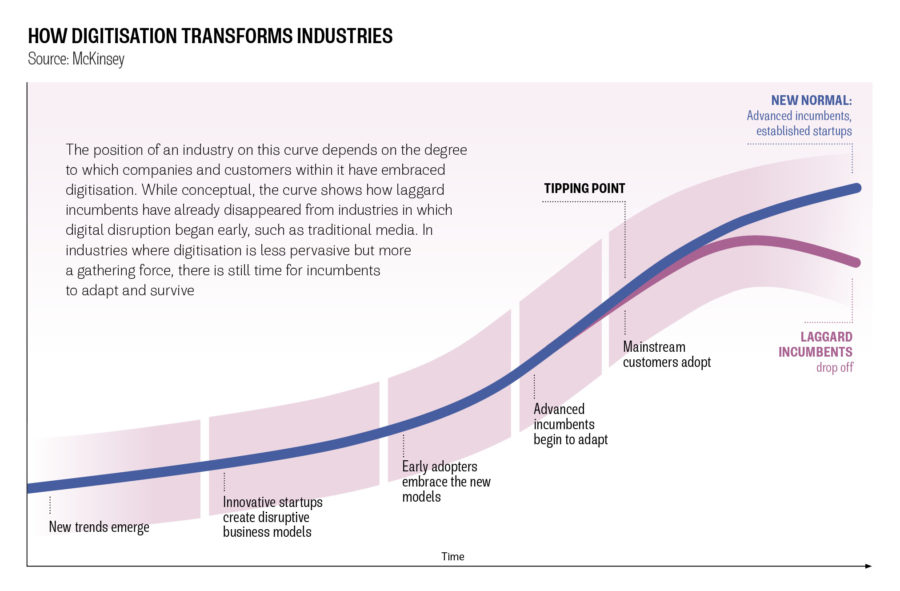More than ever, private equity investors need to understand fully where potential investments sit on their digital journey in order to support and advise appropriately. It almost goes without saying that, regardless of sector, all businesses will face a level of disruption at some stage. Is this a threat or an opportunity?
“From a private equity perspective, understanding the digital challenge is really no different to any other challenge facing a business on an evolutionary path,” says Menno Antal, managing partner and co-head of private equity at 3i. “The key is to build digital into your investment strategy rather than reinvent it. We spend time thinking about how more traditional business models can learn from more digitally advanced ones and vice versa – it’s mutually beneficial.”
Mr Antal cites meetings held with contacts in Silicon Valley to share ideas and best practice. “We had a fascinating discussion recently with Airbnb, for example. While they have come at the market from a different angle to Audley Travel, a leader in worldwide tailor-made holidays and one of 3i’s portfolio companies, there were clear shared learnings, especially around the need to personalise the customer experience,” he says.
“All travel businesses need to understand their customers better and by building deep online relationships with them, they will be able to tailor their offers more successfully, however digitally advanced their business model.
From a private equity perspective, understanding the digital challenge is really no different to any other challenge facing a business on an evolutionary path
“Broadly speaking, we are seeing a convergence of modern and more traditional business models across sectors.”
He references examples from 3i’s portfolio, including Aspen, a specialised mini pump designer, manufacturer and distributor, which has developed a new digital sensing technology for its pumps, and GEKA, a mascara brush manufacturer, which has used 3D printing to make their new product development process more efficient.
Becoming a digital forerunner
There are two typical approaches for private equity investors in the digital space. The more familiar route is to tackle the burgeoning technology, “digital-first” sector. The other, more untapped approach is in non-digital companies where digital can be used to create value.
A key opportunity for 3i, as a private equity house focused on mid-market companies across the consumer, business services and industrials sectors, lies in those mid-sized companies that accept they face a digital journey, recognise they are at risk of being disrupted, yet do not have the capability to transform by themselves. “This is where I see a lot of value being created by private equity,” says Mr Antal.
The key is to build digital into your investment strategy rather than reinvent it
And devising and executing a digital strategy goes beyond setting up e-commerce platforms. Mike Tobin, a non-executive director of several companies and former chief executive of Telecity, says: “A real digital vision requires a complex and ever-changing set of levers to equip a business to succeed in the new digital world, and the capability of the business to take advantage of them.
“It’s easy to say that ‘we have a digital strategy as we have a great transactional website’, but it’s so much more than that. You need a coherent omnichannel strategy, product and service innovation, digitisation of workflows, and improved real-time management information and systems, to name a few.
“Successfully creating and implementing such a vision can be a challenge, especially in a world that for the first time in history not only looks to improve business models constantly, but also to disrupt them actively. Yet it is essential if you are to future-proof your business.”
Mr Antal explains: “At 3i, we continue to develop our own digital strategy and network. We constantly challenge ourselves to think not only about big-picture trends and themes, but also to take a granular approach and consider the individual impact on sectors across our portfolio, and what ‘good’ looks like in each.
“As well as bringing our portfolio companies together to share knowledge and experience, we also deepen our own insight by learning from industry leaders. For example, a recent team meeting was held at McLaren’s UK head offices to observe how they apply innovative technology to drive improved performance across both products and services.”
The cost of not addressing digital change is high. “As an investor, it’s imperative to be alive to these trends and recognise their impact. There are no sectors or companies that we would look to invest in now without considering the impact of digital on the business,” Mr Antal concludes.

